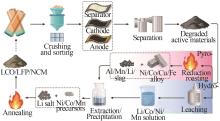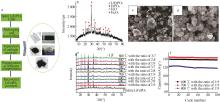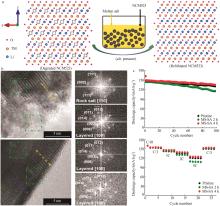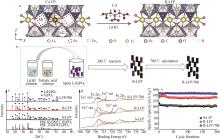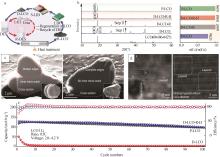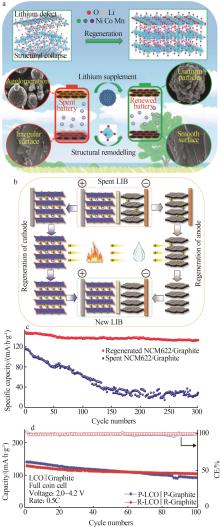Inorganic Chemicals Industry ›› 2023, Vol. 55 ›› Issue (1): 15-25.doi: 10.19964/j.issn.1006-4990.2022-0597
• Development and utilization of lithium resources • Previous Articles Next Articles
Research status and prospect on direct regeneration of cathode materials from retired lithium-ion batteries
TANG Di1( ),WANG Junxiong1,2,CHEN Wen1,JI Guanjun1,2,MA Jun1,ZHOU Guangmin1(
),WANG Junxiong1,2,CHEN Wen1,JI Guanjun1,2,MA Jun1,ZHOU Guangmin1( )
)
- 1. Tsinghua Shenzhen International Graduate School, Tsinghua University, Shenzhen 518055, China
2. Shanghai Jiao Tong University, Shanghai 200240, China
-
Received:2022-10-10Online:2023-01-10Published:2023-01-17 -
Contact:ZHOU Guangmin E-mail:td21@mails.tsinghua.edu.cn;guangminzhou@sz.tsinghua.edu.cn
CLC Number:
Cite this article
TANG Di,WANG Junxiong,CHEN Wen,JI Guanjun,MA Jun,ZHOU Guangmin. Research status and prospect on direct regeneration of cathode materials from retired lithium-ion batteries[J]. Inorganic Chemicals Industry, 2023, 55(1): 15-25.
share this article
| 1 |
LI M, LU Jun, CHEN Zhongwei, et al. 30 years of lithium-ion batteries[J].Advanced Materials, 2018, 30(33).Doi:10.1002/adma.201800561.
doi: 10.1002/adma.201800561 |
| 2 | WANG Qingsong, MAO Binbin, STOLIAROV S I, et al. A review of lithium ion battery failure mechanisms and fire prevention strategies[J].Progress in Energy and Combustion Science, 2019, 73:95-131. |
| 3 |
PIĄTEK J, AFYON S, BUDNYAK T M, et al. Sustainable Li-ion batteries:Chemistry and recycling[J].Advanced Energy Materials, 2021, 11(43).Doi:10.1002/aenm.202003456.
doi: 10.1002/aenm.202003456 |
| 4 | 赵勇强, 钟财富. 碳达峰碳中和目标下的新能源产业发展与升级[J].中国能源, 2021, 43(9):44-49, 88. |
| ZHAO Yongqiang, ZHONG Caifu. The development and upgrading of new energy industry under the goal of carbon neutrality[J].Energy of China, 2021, 43(9):44-49, 88. | |
| 5 | 张静. 跟风投锂终有时[J].汽车观察, 2022(6):62-63. |
| 6 | 况新亮, 刘垂祥, 熊朋. 锂离子电池产业分析及市场展望[J].无机盐工业, 2022, 54(8):12-19, 32. |
| KUANG Xinliang, LIU Chuixiang, XIONG Peng. Industry analysis and market prospect of lithium ion battery[J].Inorganic Chemicals Industry, 2022, 54(8):12-19, 32. | |
| 7 | XIAO Jiefeng, LI Jia, XU Zhenming. Challenges to future development of spent lithium ion batteries recovery from environmental and technological perspectives[J].Environmental Science & Technology, 2020, 54(1):9-25. |
| 8 |
QIAN Guannan, LI Zhiyuan, WANG Yong, et al. Value-creating upcycling of retired electric vehicle battery cathodes[J].Cell Reports Physical Science, 2022, 3(2).Doi:10.1016/j.xcrp.2022.100741.
doi: 10.1016/j.xcrp.2022.100741 |
| 9 | 高工产研锂电研究所. 2022年中国锂电池回收再利用市场前景分析报告[EB/OL].(2022-07-07)[2022-10-10]. |
| 10 | 中国电池研究院. 2021年中国理论废旧锂离子电池回收量逾59万吨 2026年千亿规模可期[EB/OL].(2022-03-28)[2022-10-10]. |
| 11 | ROY P, SRIVASTAVA S K. Nanostructured anode materials for lithium ion batteries[J].Journal of Materials Chemistry A, 2015, 3(6):2454-2484. |
| 12 |
YANG Zhijie, HUANG Haibo, LIN Feng. Sustainable electric vehicle batteries for a sustainable world:Perspectives on battery cathodes,environment,supply chain,manufacturing,life cycle,and policy[J].Advanced Energy Materials, 2022, 12(26).Doi:10.1002/aenm.202200383.
doi: 10.1002/aenm.202200383 |
| 13 | MA Xiaotu, HOU Jiahui, VANAPHUTI P, et al. Direct upcycling of mixed Ni-lean polycrystals to single-crystal Ni-rich cathode materials[J].Chem, 2022, 8(7):1944-1955. |
| 14 |
MURDOCK B E, TOGHILL K E, TAPIA-RUIZ N. A perspective on the sustainability of cathode materials used in lithium-ion batteries[J].Advanced Energy Materials, 2021, 11(39).Doi:10.1002/aenm.202102028.
doi: 10.1002/aenm.202102028 |
| 15 | 赵南南, 楚晓杏, 贾利军, 等. 动力电池正极材料磷酸铁锰锂制备及性能研究[J].汽车测试报告, 2022(11):115-117. |
| 16 | 自然资源部中国地质调查局国际矿业研究中心. 全球矿业发展报告2019[R].北京:自然资源部中国地质调查局中国矿业报社, 2020. |
| 17 | LV Weiguang, WANG Zhonghang, CAO Hongbin, et al. A critical review and analysis on the recycling of spent lithium-ion batteries[J].ACS Sustainable Chemistry & Engineering, 2018, 6(2):1504-1521. |
| 18 | LAI Xin, HUANG Yunfeng, GU Huanghui, et al. Turning waste into wealth:A systematic review on echelon utilization and material recycling of retired lithium-ion batteries[J].Energy Storage Materials, 2021, 40:96-123. |
| 19 | ZHANG Xiaoxiao, LI Li, FAN Ersha, et al. Toward sustainable and systematic recycling of spent rechargeable batteries[J].Che- mical Society Reviews, 2018, 47(19):7239-7302. |
| 20 |
WANG Junxiong, ZHANG Qi, SHENG Jinzhi, et al. Direct and green repairing of degraded LiCoO2 for reuse in lithium-ion batteries[J].National Science Review, 2022, 9(8).Doi:10.1093/nsr/nwac097.
doi: 10.1093/nsr/nwac097 |
| 21 |
ROY J J, RAROTRA S, KRIKSTOLAITYTE V, et al. Green recycling methods to treat lithium-ion batteries E-waste:A circular approach to sustainability[J].Advanced Materials, 2022, 34(25).Doi:10.1002/adma.202103346.
doi: 10.1002/adma.202103346 |
| 22 | YAO Yonglin, ZHU Meiying, ZHAO Zhuo, et al. Hydrometallurgical processes for recycling spent lithium-ion batteries:A critical review[J].ACS Sustainable Chemistry & Engineering, 2018, 6(11):13611-13627. |
| 23 |
MAYYAS A, STEWARD D, MANN M. The case for recycling:Overview and challenges in the material supply chain for automotive Li-ion batteries[J].Sustainable Materials and Technologies, 2019, 19.Doi:10.1016/j.susmat.2018.e00087.
doi: 10.1016/j.susmat.2018.e00087 |
| 24 | WINTER M, BARNETT B, XU Kang. Before Li ion batteries[J].Chemical Reviews, 2018, 118(23):11433-11456. |
| 25 | VETTER J, NOVÁK P, WAGNER M R, et al. Ageing mechanisms in lithium-ion batteries[J].Journal of Power Sources, 2005, 147(1/2):269-281. |
| 26 | ARORA P, WHITE R E, DOYLE M. Capacity fade mechanisms and side reactions in lithium-ion batteries[J].Journal of the Electrochemical Society, 1998, 145(10):3647-3667. |
| 27 | FAN Ersha, LI Li, WANG Zhenpo, et al. Sustainable recycling technology for Li-ion batteries and beyond:Challenges and future prospects[J].Chemical Reviews, 2020, 120(14):7020-7063. |
| 28 |
YANG Tairan, LU Yingqi, LI Liurui, et al. An effective relithiation process for recycling lithium-ion battery cathode materi-als[J].Advanced Sustainable Systems, 2020, 4(1).Doi:10.1002/adsu.201900088.
doi: 10.1002/adsu.201900088 |
| 29 |
WU Jiawei, ZHENG Mengting, LIU Tiefeng, et al. Direct recovery:A sustainable recycling technology for spent lithium-ion battery[J].Energy Storage Materials, 2022.Doi:10.1016/j.ensm.2022.09.029.
doi: 10.1016/j.ensm.2022.09.029 |
| 30 | FAN Min, CHANG Xin, MENG Qinghai, et al. Progress in the sustainable recycling of spent lithium-ion batteries[J].SusMat, 2021, 1(2):241-254. |
| 31 | NIE Hehe, XU Long, SONG Dawei, et al. LiCoO2:Recycling from spent batteries and regeneration with solid state synthesis[J].Green Chemistry, 2015, 17(2):1276-1280. |
| 32 | LI Jian, HU Leshan, ZHOU Hongming, et al. Regenerating of LiNi0.5Co0.2Mn0.3O2 cathode materials from spent lithium-ion batteries[J].Journal of Materials Science:Materials in Electronics, 2018, 29(20):17661-17669. |
| 33 | SONG X, HU T, LIANG C, et al. Direct regeneration of cathode materials from spent lithium iron phosphate batteries using a solid phase sintering method[J].RSC Advances, 2017, 7(8):4783-4790. |
| 34 | RAHMAN M M, WANG Jiazhao, HASSAN M F, et al. Basic molten salt process:A new route for synthesis of nanocrystalline Li4Ti5O12-TiO2 anode material for Li-ion batteries using eutectic mixture of LiNO3-LiOH-Li2O2 [J].Journal of Power Sources, 2010, 195(13):4297-4303. |
| 35 | REDDY M V, RAO G V S, CHOWDARI B V R. Synthesis by molten salt and cathodic properties of Li(Ni1/3Co1/3Mn1/3)O2 [J].Journal of Power Sources, 2006, 159(1):263-267. |
| 36 | BAI Ying, WANG Feng, WU Feng, et al. Influence of composite LiCl-KCl molten salt on microstructure and electrochemical performance of spinel Li4Ti5O12 [J].Electrochimica Acta, 2008, 54(2):322-327. |
| 37 | CHANG Zhaorong, CHEN Zhongjun, WU Feng, et al. The synthesis of Li(Ni1/3Co1/3Mn1/3)O2 using eutectic mixed lithium salt LiNO3-LiOH[J].Electrochimica Acta, 2009, 54(26):6529-6535. |
| 38 | CHEN Mengyuan, MA Xiaotu, CHEN Bin, et al. Recycling end-of-life electric vehicle lithium-ion batteries[J].Joule, 2019, 3(11):2622-2646. |
| 39 |
SHI Yang, ZHANG Minghao, MENG Y S, et al. Ambient-pressure relithiation of degraded Li x Ni0.5Co0.2Mn0.3O2(0<x<1) via eutectic solutions for direct regeneration of lithium-ion battery cathodes[J].Advanced Energy Materials, 2019, 9(20).Doi:10.1002/aenm.201900454.
doi: 10.1002/aenm.201900454 |
| 40 | YANG Juan, WANG Wenyu, YANG Huimeng, et al. One-pot compositional and structural regeneration of degraded LiCoO2 for directly reusing it as a high-performance lithium-ion battery cathode[J].Green Chemistry, 2020, 22(19):6489-6496. |
| 41 | ÖRNEK A, BULUT E, ÖZACAR M. The chemical,physical and electrochemical effects of carbon sources on the nano-scale LiFePO4 cathode surface[J].Ceramics International, 2014, 40(10):15727-15736. |
| 42 | LIU Xiang, WANG Mengmeng, DENG Longping, et al. Direct regeneration of spent lithium iron phosphate via a low-temperature molten salt process coupled with a reductive environment[J].Industrial & Engineering Chemistry Research, 2022, 61(11):3831-3839. |
| 43 | JING Qiankun, ZHANG Jialiang, LIU Yubo, et al. Direct regeneration of spent LiFePO4 cathode material by a green and efficient one-step hydrothermal method[J].ACS Sustainable Chemistry & Engineering, 2020, 8(48):17622-17628. |
| 44 | MAO Jianfeng, YE Chao, ZHANG Shilin, et al. Toward practical lithium-ion battery recycling:Adding value,tackling circularity and recycling-oriented design[J].Energy & Environmental Science, 2022, 15(7):2732-2752. |
| 45 | SHI Yang, CHEN Gen, LIU Fang, et al. Resolving the compositional and structural defects of degraded LiNi x Co y Mn z O2 particles to directly regenerate high-performance lithium-ion battery cathodes[J].ACS Energy Letters, 2018, 3(7):1683-1692. |
| 46 | LIU Yang, YU Hongjian, WANG Yue, et al. Microwave hydrothermal renovating and reassembling spent lithium cobalt oxide for lithium-ion battery[J].Waste Management, 2022, 143:186-194. |
| 47 | XU Panpan, DAI Qiang, GAO Hongpeng, et al. Efficient direct recycling of lithium-ion battery cathodes by targeted healing[J].Joule, 2020, 4(12):2609-2626. |
| 48 | PADHI A K, NANJUNDASWAMY K S, MASQUELIER C, et al. Effect of structure on the Fe3+/Fe2+ redox couple in iron phosphates[J].Journal of the Electrochemical Society, 1997, 144(5):1609-1613. |
| 49 | ISLAM M S, DRISCOLL D J, FISHER C A J, et al. Atomic-scale investigation of defects,dopants,and lithium transport in the LiFePO4 olivine-type battery material[J].Chemistry of Materials, 2005, 17(20):5085-5092. |
| 50 | PARK K Y, PARK I, KIM H, et al. Anti-site reordering in LiFePO4:Defect annihilation on charge carrier injection[J].Chemistry of Materials, 2014, 26(18):5345-5351. |
| 51 |
CHEN Biaobing, LIU Min, CAO Shuang, et al. Direct regeneration and performance of spent LiFePO4 via a green efficient hydrothermal technique[J].Journal of Alloys and Compounds, 2022, 924.Doi:10.1016/j.jallcom.2022.166487.
doi: 10.1016/j.jallcom.2022.166487 |
| 52 | Holbrey J D, Seddon K R. Ionic liquids[J].Clean Products and Processes, 1999, 1(4):223-236. |
| 53 | SMITH E L, ABBOTT A P, RYDER K S. Deep eutectic solvents (DESs) and their applications[J].Chemical Reviews, 2014, 114(21):11060-11082. |
| 54 | HANSEN B B, SPITTLE S, CHEN B, et al. Deep eutectic solvents:A review of fundamentals and applications[J].Chemical Reviews, 2021, 121(3):1232-1285. |
| 55 | PAIVA A, CRAVEIRO R, AROSO I, et al. Natural deep eutectic solvents-solvents for the 21st century[J].ACS Sustainable Chemistry & Engineering, 2014, 2(5):1063-1071. |
| 56 |
WANG Tao, LUO Huimin, BAI Yaocai, et al. Direct recycling of spent NCM cathodes through ionothermal lithiation[J].Advanced Energy Materials, 2020, 10(30).Doi:10.1002/aenm.202001204.
doi: 10.1002/aenm.202001204 |
| 57 | TRAN M K, RODRIGUES M T F, KATO K, et al. Deep eutectic solvents for cathode recycling of Li-ion batteries[J].Nature Energy, 2019, 4(4):339-345. |
| 58 | ZHOU Qinwen, HUANG Zixuan, LIU Jianwen, et al. A closed-loop regeneration of LiNi0.6Co0.2Mn0.2O2 and graphite from spent batteries via efficient lithium supplementation and structural remodelling[J].Sustainable Energy & Fuels, 2021, 5(19):4981-4991. |
| 59 | FUNABIKI A, INABA M,ABE T,et al. Stage transformation of lithium-graphite intercalation compounds caused by electrochemical lithium intercalation[J].Journal of the Electrochemical Society, 1999, 146(7):2443-2448. |
| 60 | AN S J, LI Jianlin, DANIEL C, et al. The state of understanding of the lithium-ion-battery graphite solid electrolyte interphase (SEI) and its relationship to formation cycling[J].Carbon, 2016, 105:52-76. |
| 61 | WANG Junxiong, MA Jun, JIA Kai, et al. Efficient extraction of lithium from anode for direct regeneration of cathode materials of spent Li-ion batteries[J].ACS Energy Letters, 2022, 7(8):2816-2824. |
| 62 |
JIA Kai, WANG Junxiong, MA Jun, et al. Suppressed lattice oxygen release via Ni/Mn doping from spent LiNi0.5Mn0.3Co0.2O2 toward high-energy layered-oxide cathodes[J].Nano Letters, 2022.Doi:10.1021/acs.nanolett.2c03090.
doi: 10.1021/acs.nanolett.2c03090 |
| 63 |
JIAO Miaolun, ZHANG Qi, YE Chenliang, et al. Recycling spent LiNi1- x- y Mn x Co y O2 cathodes to bifunctional NiMnCo catalysts for zinc-air batteries[J].Proceedings of the National Academy of Sciences of the United States of America, 2022, 119(20).Doi:10.1073/pnas.2202202119.
doi: 10.1073/pnas.2202202119 |
| [1] | ZHOU Haitao, WEN Chengqin, ZHENG Ling, SUN Jie. Research on boron nitride modified film for cathode interface of metallic lithium battery [J]. Inorganic Chemicals Industry, 2024, 56(4): 85-89. |
| [2] | LIU Dexin, MA Tengyue, AN Jinling, LIU Jinrong, HE Weiyan. Study on cathode material design and electrochemical properties of manganese-based sodium ion battery [J]. Inorganic Chemicals Industry, 2024, 56(3): 51-55. |
| [3] | ZHOU Huang, HU Xiaoping, REN Wen, CAO Xinxin. Preparation and sodium storage properties of sulfur-doped Na3(VOPO4)2F cathode materials [J]. Inorganic Chemicals Industry, 2024, 56(2): 30-37. |
| [4] | FENG Zhun. Improvement of high temperature stability of high nickel single crystal cathode materials by B/Al/Zr synergistic strategy [J]. Inorganic Chemicals Industry, 2023, 55(8): 59-64. |
| [5] | LU Junhao. Study on full element recycling process of retired ternary power lithium battery [J]. Inorganic Chemicals Industry, 2023, 55(6): 92-103. |
| [6] | ZHU Zhihong, ZHU Yongfang. Study on preparation and properties of silicon doped lithium manganate by self-propagating combustion [J]. Inorganic Chemicals Industry, 2023, 55(5): 66-70. |
| [7] | TIAN Peng, XU Jingang, XU Qianjin, LIU Kunji, PANG Hongchang, NING Guiling. Preparation of nano-alumina slurry and its application in modifying lithium-ion battery cathode material [J]. Inorganic Chemicals Industry, 2023, 55(12): 43-49. |
| [8] | PENG Chenxi, LIU Jun. Research progress of layered transition metal oxides cathode materials for sodium-ion batteries [J]. Inorganic Chemicals Industry, 2023, 55(10): 1-12. |
| [9] | YU Jianguo,SUN Qing,QIU Shengbo,ZHANG Yiren,CHEN Jun. Lithium resources development supporting national new energy strategy development [J]. Inorganic Chemicals Industry, 2023, 55(1): 1-14. |
| [10] | XU Qianjin,XU Jingang,TIAN Peng,LIU Kunji,GAO Tingting,NING Guiling. Research progress of alumina coated cathode materials for lithium-ion batteries [J]. Inorganic Chemicals Industry, 2023, 55(1): 46-55. |
| [11] | HOU Shunli,ZHAO Duan,ZHOU Geng,WEI Shishi,LI Jian,WANG Jiatai. Research progress on doping modification of high nickel ternary nickel-cobalt-aluminum cathode material [J]. Inorganic Chemicals Industry, 2022, 54(8): 40-46. |
| [12] | QIU Zhixu,ZHU Shaokuan,WEI Yuxiao,LONG Jiaying,HUANG Dongchuang,SHAO Jiaojing. Study on preparation and electrochemical performance of S/MCNT/Fe3O4 cathode materials [J]. Inorganic Chemicals Industry, 2022, 54(6): 73-77. |
| [13] | DONG Peng,ZHOU Yingjie,HOU Minjie,YANG Dongrong,DAI Yongnian,LIANG Feng. Research progress on Na3V2(PO4)3 cathode materials for sodium ion batteries [J]. Inorganic Chemicals Industry, 2022, 54(5): 1-10. |
| [14] | WEI Chunguang,LIANG Yan,LI Tong,LÜ Wei. Research and industrialization progress of aqueous zinc ion battery [J]. Inorganic Chemicals Industry, 2022, 54(3): 18-22. |
| [15] | ZHANG Xinyi,DI Yuli,DONG Qi,CHEN Xingyu,ZHANG Zhengdong. Research progress on preparation of Li3V2(PO4)3 cathode material for lithium-ion batteries [J]. Inorganic Chemicals Industry, 2022, 54(3): 38-44. |
| Viewed | ||||||
|
Full text |
|
|||||
|
Abstract |
|
|||||
|
||
